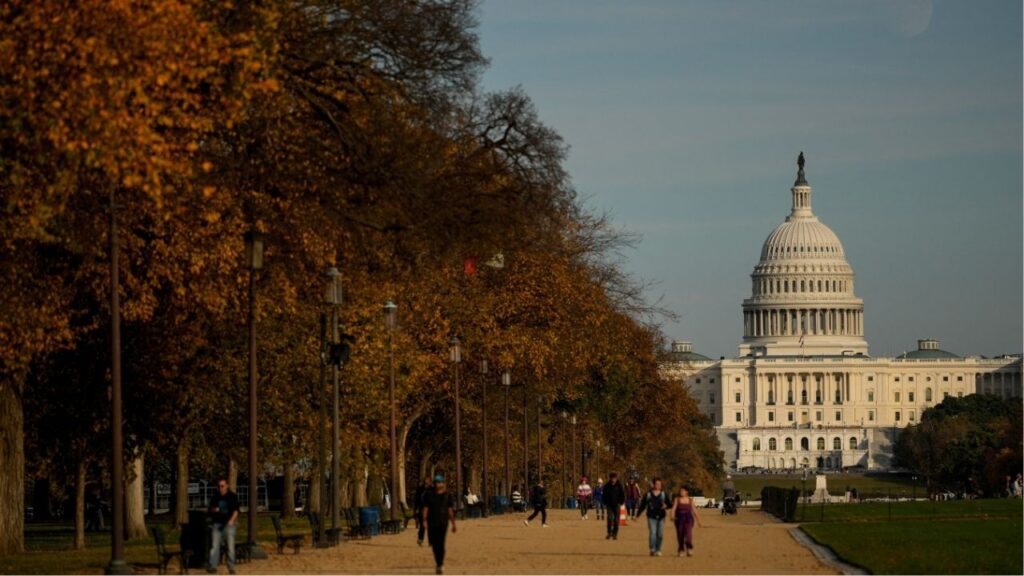Share
SEQUOIA NATIONAL PARK — Sequoia National Park is shut down, its namesake gigantic trees potentially threatened by two forest fires burning in steep and dangerous terrain in California’s Sierra Nevada.
Both fires were projected to advance in the direction of Giant Forest, home to more than 2,000 giant sequoias including the General Sherman Tree, which is the largest tree on Earth by volume.
The massive sequoias grow on the western slope of the Sierra Nevada. The General Sherman Tree stands 275 feet and is over 36 feet in diameter at the base, according to the U.S. National Park Service.
“There’s no imminent threat to Giant Forest but that is a potential,” Mark Ruggiero, fire information officer for Sequoia and Kings Canyon national parks, said Tuesday.
Ruggiero estimated that the closest flames were about a mile from the grove. Sequoia headquarters personnel, about 75 people, were being evacuated, he said.
The Colony and Paradise fires, named for locations where they started, were ignited by lightning last week and were being battled collectively under the name of the KNP Complex. Their combined sizes grew to more than nine square miles late Tuesday, with fire jumping over the Generals Highway.
A total of 300 personnel are on the scene battling the blazes, authorities said. There is 0% containment thus far.
Evacuation Orders, Community Meeting Video
To view a video of the community meeting that took place Tuesday night in Three Rivers, visit https://www.facebook.com/SequoiaKingsNPS/videos/1187358425009799
The mandatory evacuation order by the Tulare County Sheriff’s Office has expanded to include the following areas of Three Rivers:
- All of Mineral King Road, from the intersection with Highway 198 to the end of the road
- Areas along Sierra King Drive, Crest Lane, Hammond Drive, and Oak Grove Drive
- Areas along Highway 198 from the intersection with Mineral King Road to the Sequoia National Park entrance station
The evacuation warning has expanded to include all of the community of Three Rivers, from Edison Drive west to the Mineral King Road. This includes North Fork Drive, South Fork Drive, Cherokee Oaks, Old Three Rivers Road, and Blossom Drive.
For a detailed map of evacuation warning and evacuation order areas, visit https://tularecounty.ca.gov/emergencies/

Kings Canyon National Park Remains Open
All park facilities were already closed and wilderness trailhead permits had been canceled. The Silver City retreat and the summer cabins of Cabin Cove were under evacuation orders. Part of the community of Three Rivers outside the park entrance was under an evacuation warning.
However, Kings Canyon National Park, to the north of Sequoia, remained open.
The potential threat to the giant sequoias came just a year after a disastrous complex of fires in the same region.
Part of the wildfire complex known as the Castle Fire destroyed 10% of the population of sequoias, Ruggiero said.

Sequoias Are Fire Resistant
Sequoias rely on fire for such processes as releasing seeds from cones and making clearings in the forest that allow seedlings to grow. The record of burns in the rings of trees thousands of years old demonstrates their relationship to fire.
But changing climate has intensified forest fires and their impact.
“Sequoia trees are a fire-adaptive tree,” Ruggiero said. “It’s important to have fire to have sequoias thrive, but when we get such intense fires even the sequoias can’t stand up to them.”
Giant sequoias are closely related to the towering, slender redwoods that grow along the Northern California coast and have the same relationship with fire.
That interaction was tested last year when a huge fire tore through almost all of Big Basin Redwoods State Park on the coast between San Francisco and Monterey Bay.
A week after the fire, an Associated Press reporter and photographer hiked the renowned Redwood Trail and confirmed that most of the ancient redwoods, about 2,000 years old, had survived. Months later there were signs of new growth.
California has had more than 7,400 wildfires so far this year, scorching more than 3,500 square miles.
California’s second-largest fire on record, the Dixie Fire, remained 75% contained after burning 1,500 square miles in the northern Sierra and southern Cascades region. Near Lake Tahoe, containment of the 342-square-mile Caldor Fire increased to 68%.
(GV Wire contributed to this story.)
RELATED TOPICS:
Categories

Dan Bongino to Step Down From FBI

Judge Allows Trump’s Ballroom Project to Proceed for Now

Canva Down for Thousands, Downdetector Reports
















